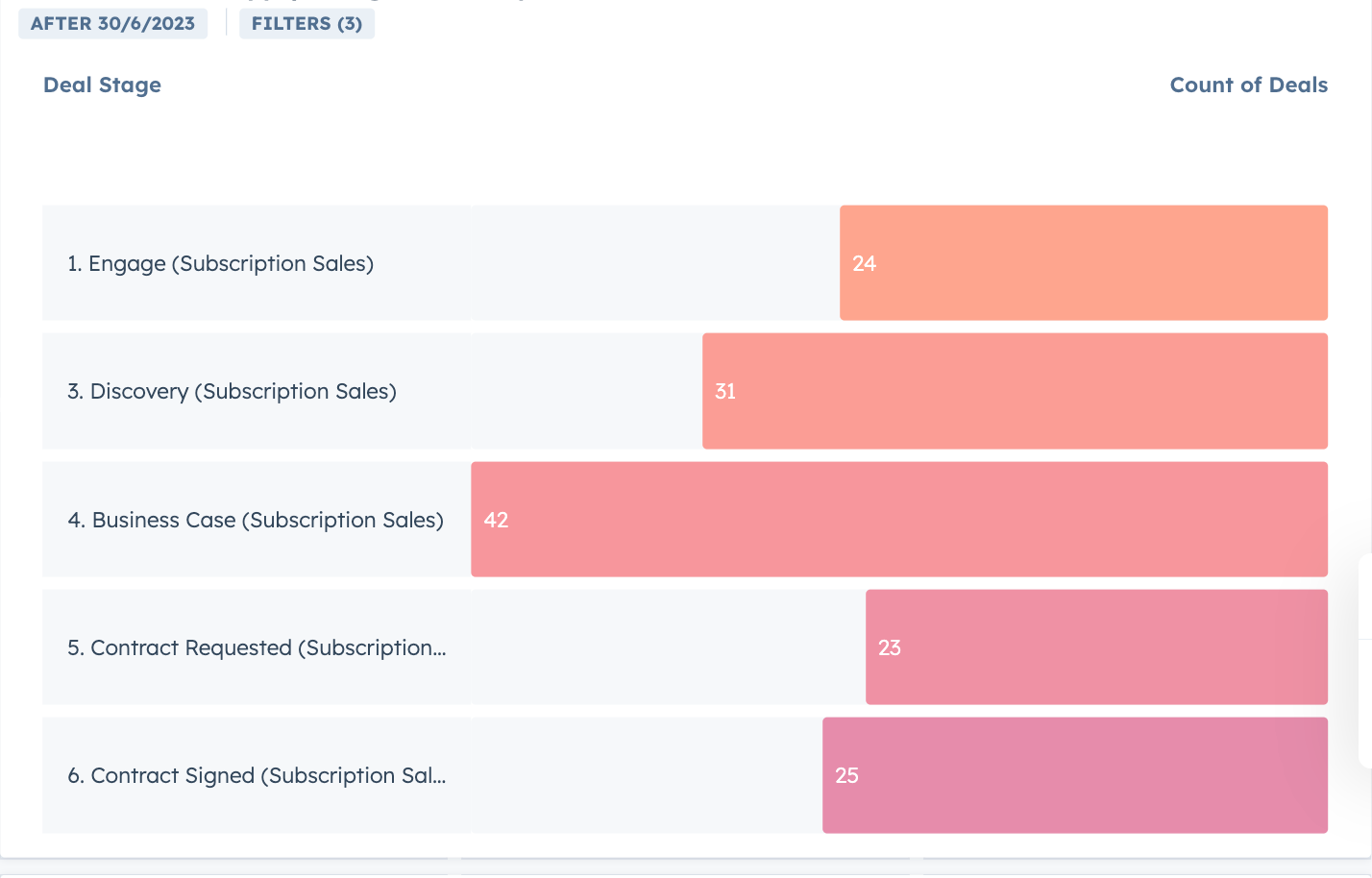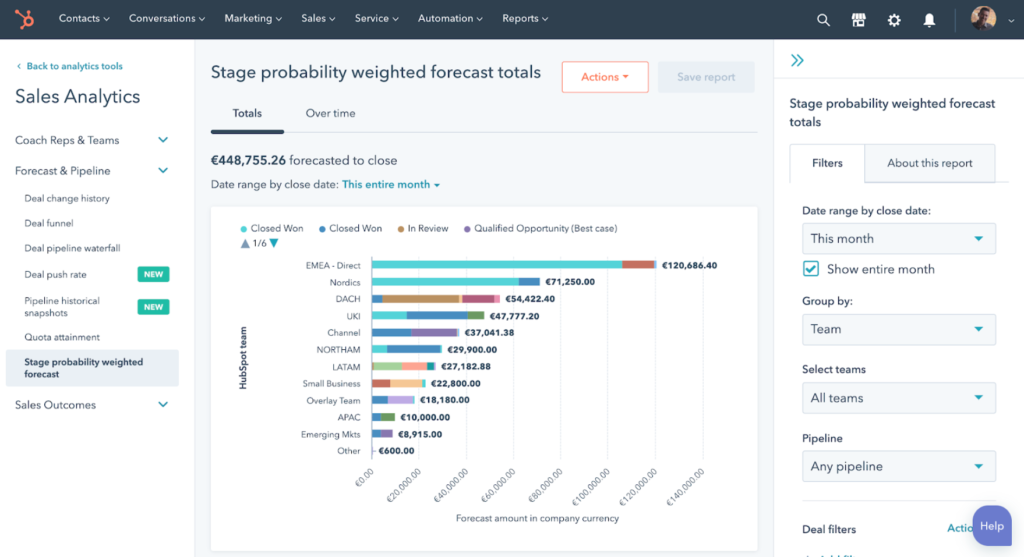Getting your sales pipeline right in HubSpot isn’t just about staying organized; it’s about making sure your data is clear, actionable, and reliable. Without a well-structured pipeline, your reports can become skewed, leading to inaccurate forecasts and missed opportunities for your business.
A well-built pipeline helps you to make sure that every deal is tracked properly, giving you a true picture of what’s happening in your sales process.
How does your pipeline structure affect reporting?
Your sales pipeline is more than just a list of stages. It forms the backbone of your reporting, so the way you structure it will directly influence your ability to monitor key metrics like conversion rates and deal velocity. If your stages don’t reflect the reality of your sales cycle, your reports aren’t going to tell the full story.
Let’s use the “Proposal Sent” stage as an example. By clearly defining this stage, you can track how many proposals move forward to a closed deal. This stage will also provide insight into how long deals tend to stay in the proposal phase before moving forward or falling off your pipeline.
On the flip side, if your stages are vague or too broad, you could end up blurring the lines between different phases of the sales process, making it hard to get accurate data.
Why vague stages can lead to bad data
When the stages in your pipeline aren’t well-defined, it becomes hard to know where a deal truly stands. Imagine a “Negotiation” stage that covers everything from the first discussion about pricing to final contract review. Such a wide range of activities under one stage could obscure valuable insights, like how close a deal is to closing or where potential delays might be happening.
By breaking down broad stages into more specific ones, you’ll get a clearer view of the actual sales journey, making your reports far more actionable.

When to overhaul your pipeline
Even the best pipeline needs a tune-up now and then. As your business evolves, so should your pipeline. A pipeline that worked perfectly when you were smaller might not scale well as your sales process becomes more complex. Here are a couple of signs that it’s time to rethink your setup:
- If deals are consistently getting stuck in certain stages (like “Proposal Sent”) it’s worth examining whether that stage needs to be broken down further.
- If your sales forecasts are frequently off, it’s possible that your pipeline doesn’t accurately reflect the steps deals actually go through. When the stages don’t match your process, your reports and forecasts won’t either.
How to audit your pipeline for improvement
A regular audit helps ensure your pipeline stays aligned with your sales process. Here’s a quick way to review and refine it:
- Review current stages: Look at each stage. Does it reflect your current sales process, or is it outdated? Remove or update any stages that no longer apply.
- Analyze deal flow: Use HubSpot reports to identify stages where deals get stuck. If certain stages, like “Proposal Sent,” have long delays, consider breaking them into smaller, more specific steps.
- Check for overlap: Look for stages that might be redundant. For example, if “Negotiation” and “Final Pricing” are similar, you may want to merge them.
- Spot missing stages: Are there steps in your process not reflected in the pipeline? Add new stages if key actions, like “Contract Review,” are missing.
- Get feedback from your sales team: Your team knows where the pipeline doesn’t match their workflow. Ask them which stages feel unclear or unnecessary.
- Test and adjust: Before making big changes, test updates on a few deals to ensure they improve clarity without adding confusion.
What stages should be in your HubSpot pipeline?
There’s no one-size-fits-all when it comes to pipeline stages, but there are some tried-and-true stages that most businesses can benefit from. These include:
- Lead Qualification: Sorting out which leads are worth pursuing.
- Proposal Sent: Tracking how many leads are progressing to the proposal stage.
- Closed Won/Closed Lost: Knowing the final outcome of your deals.
However, the key to a successful pipeline is customization. The stages should reflect the reality of your sales process.
Customizing your pipeline
Tailoring your pipeline is essential for making sure it truly supports your sales team’s work. A pipeline that reflects your actual sales journey gives you the insights you need to improve performance and plan strategically.
For example, if you’re selling both services and products, you might want to create separate pipelines or stages for each. This way, you can track progress, challenges, and success rates more accurately across different areas of your business. Customization doesn’t just make your pipeline more accurate, it makes it more useful.
Weighting your pipeline stages for forecasting
Good forecasting is all about understanding the likelihood of deals closing at each stage of your pipeline. By assigning weights to each stage, you can more accurately predict future revenue and resource needs.

Using weighted stages
Weighting your pipeline stages means giving each stage a probability of success. For example:
- A deal in the “Negotiation” stage might have an 80% chance of closing.
- A lead in “Qualification” might only have a 20% chance of moving forward.
These percentages aren’t guesses; they’re based on your historical data. By knowing the likelihood of deals closing at each stage, you can make more accurate forecasts and plan your resources accordingly.
Adjusting your weights over time
Like anything in sales, these weights aren’t set in stone. As you gather more data, you’ll need to adjust your weights. If only 50% of deals in the “Proposal Sent” stage actually close, then the weight should reflect that, perhaps dropping from 70% to 50%.
Regularly reviewing and adjusting your stage weights keeps your forecasting aligned with reality, giving you more control over your revenue predictions.
How to build or overhaul a pipeline in HubSpot
Whether you’re starting from scratch or updating an old pipeline, HubSpot makes it simple to set up a system that works for your team.
For existing pipelines
When refreshing an existing pipeline, you’ll want to preserve historical data. Instead of deleting old stages, modify them. If you find that “Proposal Sent” is too vague, try breaking it into “Proposal Sent” and “Contract Review.” This way, you keep past data intact while improving it going forward.
For new pipelines
If you’re building a pipeline from the ground up? Start with the basics that we covered above in the section about what stages should be in your HubSpot pipeline.
From there, you’ll want to tweak the stages to match your sales process. If your process has a lot of moving parts, consider adding intermediate stages to capture important steps. Keep reviewing the pipeline regularly to ensure it continues to reflect the real-world sales journey.
Fine-tuning your deal properties
While your pipeline stages capture the broad flow of a deal, deal properties help you drill down into the details. Keeping these properties up-to-date means your reporting will remain clean and relevant.
Customizing deal properties for better insights
Default properties are fine for basic reporting, but creating custom properties can give you deeper insights. For instance, adding a “Lead Source” property helps you track where your most valuable leads come from. This extra data lets you refine your marketing strategies and focus on the channels that drive the best results.
Automating your pipeline for better reporting
Automation helps your pipeline reflect the true status of your deals in real-time. By automating deal movement and setting up triggers, you can keep your pipeline up-to-date without manual input.
Automating deal movement
You can set up rules in HubSpot that automatically move deals to the next stage based on specific actions or criteria. For example, if a deal hits a certain value, it can automatically move from “Lead Qualification” to “Negotiation”. This keeps everything flowing smoothly without manual updates.
Using triggers to stay on track
Triggers can help prevent deals from stalling. If a deal stays in “Proposal Sent” for more than two weeks, a trigger can alert a sales rep to follow up. This keeps deals moving and ensures that nothing slips through the cracks.
Reporting from your HubSpot pipeline
A well-structured pipeline allows you to generate reports that give you valuable insights into your sales process. To get the most from your pipeline, make sure you’re generating reports like:
- Conversion rates: How effectively are leads moving from one stage to the next?
- Deal velocity: How quickly are deals progressing?
These reports offer a wealth of insight into your team’s performance, helping you identify areas where the process might be slowing down.
Using reports to drive performance
At this point, your reports should be ready to share more widely in your team, and can be used to drive team performance in real-time. After you get your pipeline performing better, you can use Geckoboard to share HubSpot reporting live on screen from your HQ, ensuring everyone stays on track and aligned with key goals. Sign up to give it a try.

